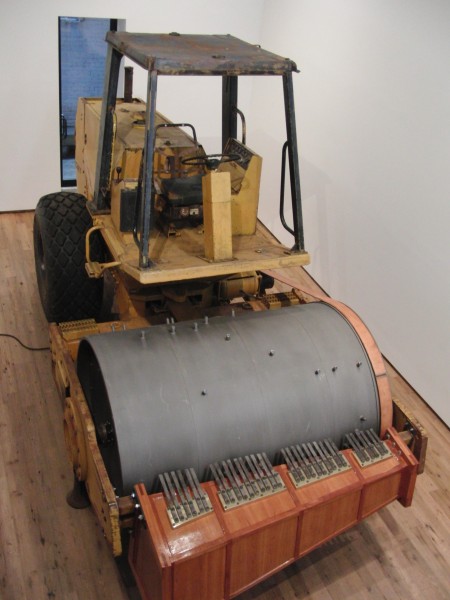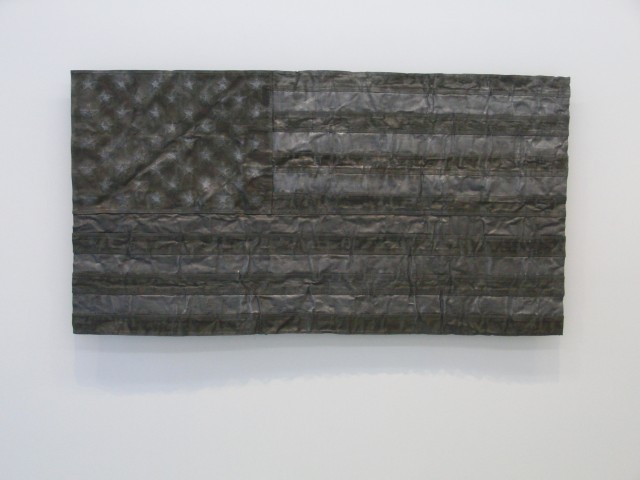
Dave Cole, “The Music Box,” Caterpillar CS-533 Vibratory Roller-Compactor with cherry wood, spring steel, and United States National Anthem (arranged for steamroller), 2012 (photo by twi-ny/mdr)
DODGEgallery
15 Rivington St. between Bowery & Chrystie St.
Wednesday – Sunday through October 28, free
212-228-5122
www.dodge-gallery.com
www.davecoledavecole.com
dave cole slideshow
For New Hampshire–based artist Dave Cole, the carefully chosen materials he uses and the act of creation itself are as important as the final result. For past shows, in a studio that is more like an industrial workshop, he has made a large-scale teddy bear out of fiberglass, Native American breastplates out of military cartridges, a snowsuit using a Gulf War bulletproof vest, and an elegant gown composed of U.S. currency. Although he prefers not to make grand statements about his work, he does acknowledge that his pieces explore the dichotomy that is America, a land of hope and dreams as well as violence and war. “With my family’s background — four generations of people who left Europe fleeing religious persecution — it’d be ridiculous if I didn’t celebrate America,” Cole said several years ago. “On the other hand, it’d be unconscionable and deliberately ignorant of me to not call bullshit on America’s abuses.” For his second solo exhibition at DODGEgallery, Cole expands on that theme with an installation that explores the past, present, and future of a country still in search of its identity, beginning with the latest in his flag series, “American Flag (Lead),” an official-size U.S. flag hand sewn out of a lead sheet with stainless-steel cables and then run over by a pickup truck, representing an America that has been trampled on but can’t be destroyed. For “Song-Books of the War,” inspired by a WWI-era poem by Siegfried Sassoon (“In fifty years, when peace outshines / Remembrance of battle lines, / Adventurous lads will sigh and cast / Proud looks upon the plundered past.”), Cole has taken an old-fashioned wood-and-wicker wheelchair, which was once used by a member of his family, and placed on it approximately twenty thousand buffalo nickels that weigh the same as Cole, the artist feeling the weight of his personal and professional responsibilities. Known for his knitting of small and large objects, including a huge acrylic flag knitted with John Deere excavators in the Mass MoCA parking lot, Cole here includes “Singer,” a sewing machine that is hooked up to the internet, Googling itself and spewing out the search results in binary code onto a strip of bright yellow teletype paper. The brand name and sound are key here, evoking Walt Whitman’s “Song of Myself”; Cole has been strongly influenced by some of America’s greatest poets, including Whitman, Carl Sandburg, and T. S. Eliot.

Dave Cole, “American Flag (Lead),” lead sheet and stainless-steel cable, hand sewn, 2012 (photo by twi-ny/mdr)
In 2008, Cole fashioned a series of baby bottles out of cast Babbitt metal to military specifications. In the new show, he includes “Three Generations,” a trio of baby rattles in the form of hand grenades from WWII, the Vietnam War, and the more recent wars in Iraq and Afghanistan, made out of hand-turned hardwood and sterling silver. “Belt Plate (after Antietam)” is a boxing-size championship belt made from melted bullets and recycled lead type featuring the letters “US” on it, memorializing the bloodiest day in American history, when twenty-three thousand soldiers died in the 1862 Civil War battle. “The Star-Spangled Banner” might be played at the beginning of sports events and when U.S. Olympic athletes win gold medals, but Cole’s exhibition ends with a rather unique interpretation of the song, which was written in 1814 by Francis Scott Key after he witnessed the Battle of Fort McHenry. The centerpiece of the show (and accompanied by a maquette), “The Music Box” is a massive steamroller that barely fits into the downstairs space at Dodge. Commissioned by the Cleveland Institute of Art, it is a reconstructed thirteen-ton Caterpillar CS-533 Vibratory Roller-Compactor that Cole disassembled, then reassembled in exacting detail using more lightweight materials (as revealed by a video that plays next to it), adding a steel comb and tuning teeth to the drum so it plays a haunting rendition of the National Anthem as it turns. The song itself is famously difficult to sing, and this version, performed by an instrument of destruction and construction, makes that even more apparent, yet at the same time it is a symbol of America’s success and pride and innate ability to survive. A true craftsman, Cole has once again infused his work with multilayered nuances, both overt and covert, not afraid to face some hard truths about the country that he loves.